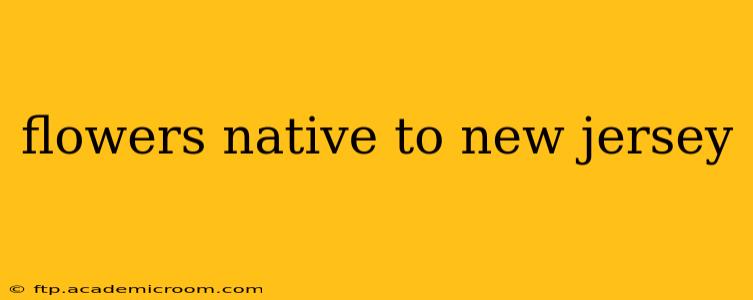New Jersey, with its diverse geography ranging from the Pine Barrens to the coastal plains, boasts a rich tapestry of native wildflowers. These beautiful blooms not only add vibrant color to the landscape but also play a crucial role in supporting local ecosystems. Understanding which flowers are native to the area is essential for gardeners looking to create a sustainable and ecologically beneficial garden, attracting pollinators and supporting biodiversity. This guide explores some of the stunning flowers you can find naturally growing in the Garden State.
What are some common native New Jersey wildflowers?
New Jersey's diverse habitats support a wide array of native wildflowers. Some of the most common and easily recognizable include:
-
Black-eyed Susans (Rudbeckia hirta): These cheerful yellow daisies with dark brown centers are a ubiquitous sight in fields and meadows throughout the state. Their hardiness and ease of cultivation make them a popular choice for gardens as well.
-
Butterfly Weed (Asclepias tuberosa): A striking orange milkweed, this plant is vital for monarch butterfly populations. Its vibrant color and unique flower structure make it a beautiful addition to any pollinator garden.
-
Blue Flag Iris (Iris versicolor): This elegant iris displays beautiful blue-purple flowers along wetlands and damp meadows. Its tolerance for moist conditions makes it a valuable plant for rain gardens and areas prone to waterlogging.
-
New England Aster (Symphyotrichum novae-angliae): These late-blooming asters bring a burst of purple to the autumn landscape, providing a crucial late-season food source for pollinators. Their vibrant color and late blooming period make them a valuable addition to any garden designed to support pollinators throughout the year.
-
Wild Bergamot (Monarda fistulosa): This fragrant mint family member boasts clusters of lavender-pink flowers and attracts hummingbirds and bees. Its aromatic leaves also have culinary and medicinal uses.
What are some less common, but equally beautiful, native flowers of New Jersey?
Beyond the commonly known wildflowers, New Jersey harbors a treasure trove of less common yet equally captivating native species. These often require more specific habitat conditions but offer unique beauty and ecological significance:
-
Grass Pink Orchid (Calopogon tuberosus): This delicate orchid with its vibrant pink flowers thrives in acidic bogs and wetlands. Its presence indicates a healthy, undisturbed ecosystem.
-
Fringed Gentian (Gentianopsis crinita): This rare and endangered gentian boasts stunning fringed, blue flowers. Its presence is a testament to the pristine condition of its habitat.
-
Swamp Milkweed (Asclepias incarnata): A taller, more elegant milkweed than butterfly weed, this species prefers moist or wet soils and is crucial for supporting monarch butterfly populations.
-
Spiderwort (Tradescantia ohiensis): These easy-to-grow wildflowers feature three-petaled flowers in various shades of blue or purple, often with contrasting yellow stamens. They are quite common in the state and add a delicate touch to any garden setting.
What are some of the best places to see native New Jersey wildflowers?
Many state parks and preserves offer opportunities to observe native wildflowers in their natural habitat. Some excellent locations include:
-
Delaware Water Gap National Recreation Area: This area boasts diverse habitats supporting a wide array of wildflowers.
-
Pines National Reserve: This vast expanse of the New Jersey Pine Barrens is home to many unique and rare species adapted to the sandy soil.
-
Various county parks and nature preserves: Check your local county’s parks and recreation department for information on trails and areas known for their wildflowers.
How can I encourage native flowers to grow in my garden?
Creating a garden that thrives with New Jersey's native flora is both environmentally responsible and aesthetically rewarding. Consider these steps:
-
Choose native plant species: Opt for plants adapted to your local conditions to avoid the need for excessive watering and fertilization.
-
Prepare the soil: Amend the soil with compost or other organic matter to improve drainage and fertility.
-
Avoid pesticides and herbicides: These chemicals can harm beneficial insects and other wildlife.
-
Provide appropriate sunlight and moisture: Research the specific needs of each plant species.
-
Control invasive species: Remove invasive plants that compete with native flora.
By incorporating native flowers into your garden, you contribute to a healthier ecosystem while enjoying the beauty of the Garden State’s natural flora. Remember to always practice responsible gardening and research the specific needs of the plants you choose to ensure their success.
